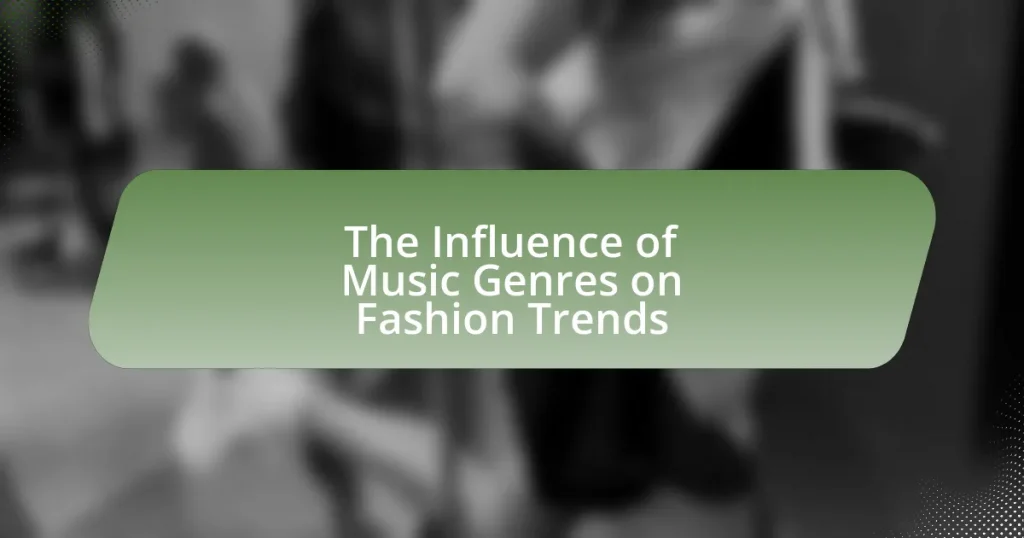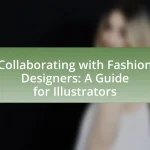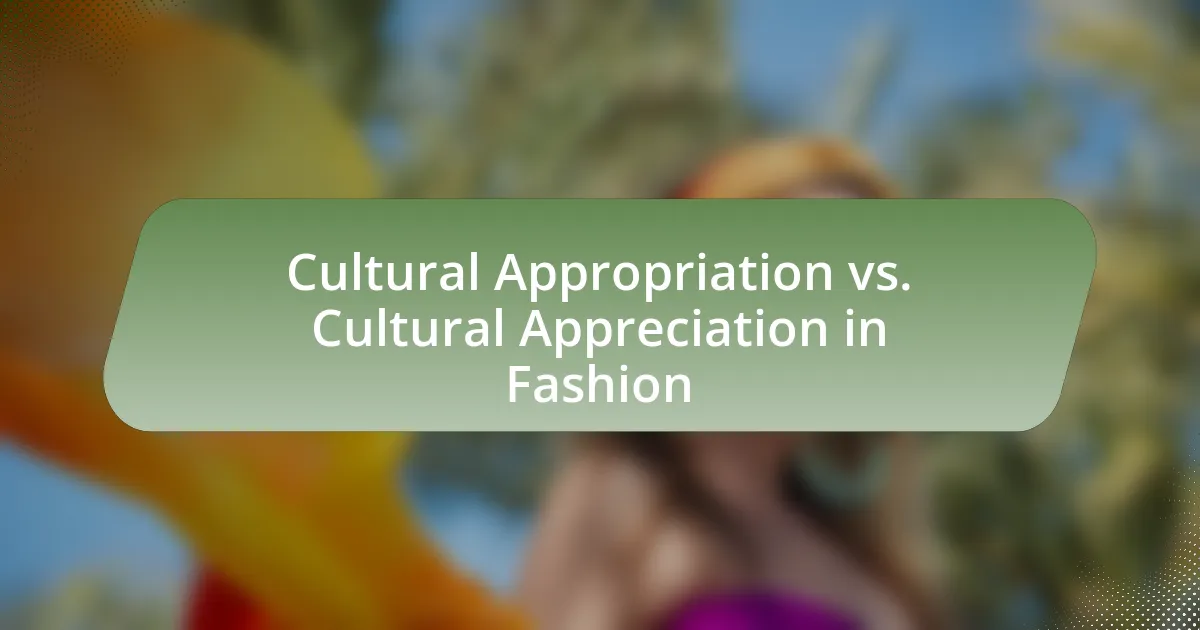The article examines the significant influence of music genres on fashion trends, highlighting how various musical movements shape styles, aesthetics, and cultural expressions. It discusses the distinct fashion characteristics associated with genres such as punk, hip-hop, rock, and electronic music, illustrating how artists and musicians serve as cultural icons that impact consumer choices. The interplay between music and fashion is further explored through historical examples, collaborations between artists and designers, and the role of social media in promoting trends. Additionally, the article addresses future trends in the relationship between music and fashion, emphasizing sustainability and digital integration.

What is the Influence of Music Genres on Fashion Trends?
Music genres significantly influence fashion trends by shaping the styles, aesthetics, and cultural expressions associated with different musical movements. For instance, the punk rock genre in the 1970s popularized leather jackets, ripped jeans, and bold hairstyles, reflecting its rebellious ethos. Similarly, hip-hop culture has driven trends such as oversized clothing, sneakers, and streetwear, which have become mainstream fashion staples. The connection between music and fashion is further evidenced by collaborations between artists and fashion designers, such as Rihanna’s partnership with Puma, which merges musical identity with fashion innovation. This interplay illustrates how music genres not only inspire individual style choices but also impact broader fashion industry trends.
How do different music genres shape fashion choices?
Different music genres significantly shape fashion choices by influencing the styles, colors, and overall aesthetics that fans adopt. For instance, punk music has historically been associated with edgy, rebellious fashion characterized by leather jackets, ripped jeans, and bold hairstyles, reflecting the genre’s anti-establishment ethos. In contrast, hip-hop culture has popularized streetwear, including oversized clothing, sneakers, and accessories like caps and chains, which emphasize comfort and urban identity. Additionally, genres like country music often promote a more rustic style, featuring denim, cowboy boots, and plaid shirts, aligning with the genre’s themes of rural life and tradition. These fashion choices are not only expressions of personal identity but also serve as visual representations of the cultural values and social movements associated with each genre.
What are the key characteristics of fashion associated with various music genres?
Fashion characteristics associated with various music genres include distinct styles that reflect the cultural and aesthetic values of each genre. For example, punk fashion is characterized by leather jackets, ripped jeans, and DIY elements, symbolizing rebellion and anti-establishment sentiments. In contrast, hip-hop fashion often features oversized clothing, sneakers, and bold accessories, representing urban culture and self-expression.
Rock music is associated with a more edgy look, including band t-shirts, skinny jeans, and combat boots, which convey a sense of individuality and attitude. Country music fashion typically includes cowboy hats, boots, and denim, reflecting rural roots and traditional values.
Electronic dance music (EDM) fashion is known for vibrant colors, neon lights, and festival wear, emphasizing a sense of freedom and celebration. Each genre’s fashion not only serves as a visual representation of the music but also influences broader fashion trends, as seen in the adoption of punk elements in mainstream fashion during the 1970s and 1980s.
How do artists and musicians impact fashion trends within their genres?
Artists and musicians significantly impact fashion trends within their genres by serving as cultural icons whose styles are emulated by fans and the broader public. For instance, the punk rock movement of the 1970s, led by bands like the Sex Pistols, popularized a rebellious aesthetic characterized by leather jackets, ripped jeans, and bold hairstyles, which became synonymous with the genre. Similarly, hip-hop artists such as Run-D.M.C. and later Kanye West have influenced streetwear trends, integrating sportswear and high fashion into everyday attire, which has led to a lasting impact on global fashion markets. This influence is further evidenced by collaborations between musicians and fashion brands, such as Rihanna’s partnership with Puma, which showcases how artists can shape consumer preferences and drive trends within their respective genres.
Why is the relationship between music and fashion significant?
The relationship between music and fashion is significant because they mutually influence each other, shaping cultural identity and trends. Music genres often dictate fashion styles, as seen in the punk movement of the 1970s, where artists like the Sex Pistols popularized leather jackets and ripped jeans, reflecting rebellion and nonconformity. This influence is further evidenced by the hip-hop culture, which has driven trends such as oversized clothing and sneakers, originating from the artists’ lifestyles and social messages. The interplay between these two domains not only reflects societal changes but also drives consumer behavior, as fans emulate the styles of their favorite musicians, creating a cyclical relationship that continuously evolves.
What cultural factors contribute to the influence of music on fashion?
Cultural factors such as social movements, subcultures, and historical contexts significantly contribute to the influence of music on fashion. For instance, the punk music movement of the 1970s, characterized by its anti-establishment ethos, led to the adoption of distinctive fashion styles like leather jackets and ripped jeans, reflecting the rebellious spirit of the genre. Additionally, hip-hop culture has shaped streetwear trends, with artists like Run-D.M.C. popularizing athletic wear and oversized clothing, which became symbols of urban identity. Furthermore, the globalization of music has facilitated cross-cultural exchanges, allowing diverse fashion influences to emerge, as seen in the fusion of traditional garments with contemporary styles in various music scenes. These examples illustrate how music not only reflects cultural sentiments but also actively shapes fashion trends through its connection to societal values and identities.
How does fashion serve as a form of expression in music genres?
Fashion serves as a form of expression in music genres by visually representing the themes, values, and identities associated with those genres. For instance, punk music is characterized by its rebellious spirit, which is reflected in the fashion choices of its artists and fans, such as leather jackets, ripped jeans, and bold hairstyles. This visual representation not only communicates the genre’s ethos but also fosters a sense of community among its followers. Historical examples include the 1970s disco scene, where vibrant colors and flashy outfits symbolized the era’s celebration of freedom and self-expression. Thus, fashion acts as a crucial medium through which music genres convey their cultural narratives and connect with audiences.
What historical examples illustrate the influence of music on fashion?
The influence of music on fashion is exemplified by the punk rock movement of the 1970s, which introduced a distinctive style characterized by ripped clothing, leather jackets, and bold hairstyles. This fashion was heavily influenced by bands like the Sex Pistols and The Ramones, who embodied a rebellious attitude that resonated with youth culture. Another significant example is the hip-hop culture of the 1980s and 1990s, where artists like Run-D.M.C. popularized streetwear, including oversized clothing, sneakers, and baseball caps, which became mainstream fashion staples. Additionally, the glam rock era of the 1970s, led by artists such as David Bowie and Elton John, showcased extravagant costumes and makeup, influencing fashion with its theatrical and androgynous styles. These historical examples illustrate how music genres have shaped fashion trends, reflecting cultural movements and societal changes.
How did the punk movement affect fashion trends in the 1970s?
The punk movement significantly influenced fashion trends in the 1970s by promoting a rebellious and anti-establishment aesthetic. This movement introduced elements such as ripped clothing, leather jackets, band t-shirts, and distinctive hairstyles like brightly colored mohawks and spiked hair. The use of DIY (do-it-yourself) fashion became prevalent, with individuals customizing their clothing to express individuality and defiance against mainstream culture. Notably, designers like Vivienne Westwood and Malcolm McLaren played crucial roles in shaping punk fashion, showcasing these styles in their boutique, SEX, in London. The punk movement’s emphasis on nonconformity and self-expression left a lasting impact on fashion, inspiring future generations and leading to the emergence of various subcultures.
What role did hip-hop play in shaping streetwear culture?
Hip-hop played a pivotal role in shaping streetwear culture by establishing a unique style that merged music, art, and fashion. The genre’s artists, such as Run-D.M.C. and A Tribe Called Quest, popularized athletic wear, oversized clothing, and bold graphics, which became staples of streetwear. This influence is evidenced by the collaboration between hip-hop artists and major brands like Adidas and Nike, which helped to elevate streetwear from subculture to mainstream fashion. The cultural significance of hip-hop in streetwear is further highlighted by the emergence of brands like Supreme and Off-White, which draw inspiration from hip-hop aesthetics and have become synonymous with the streetwear movement.
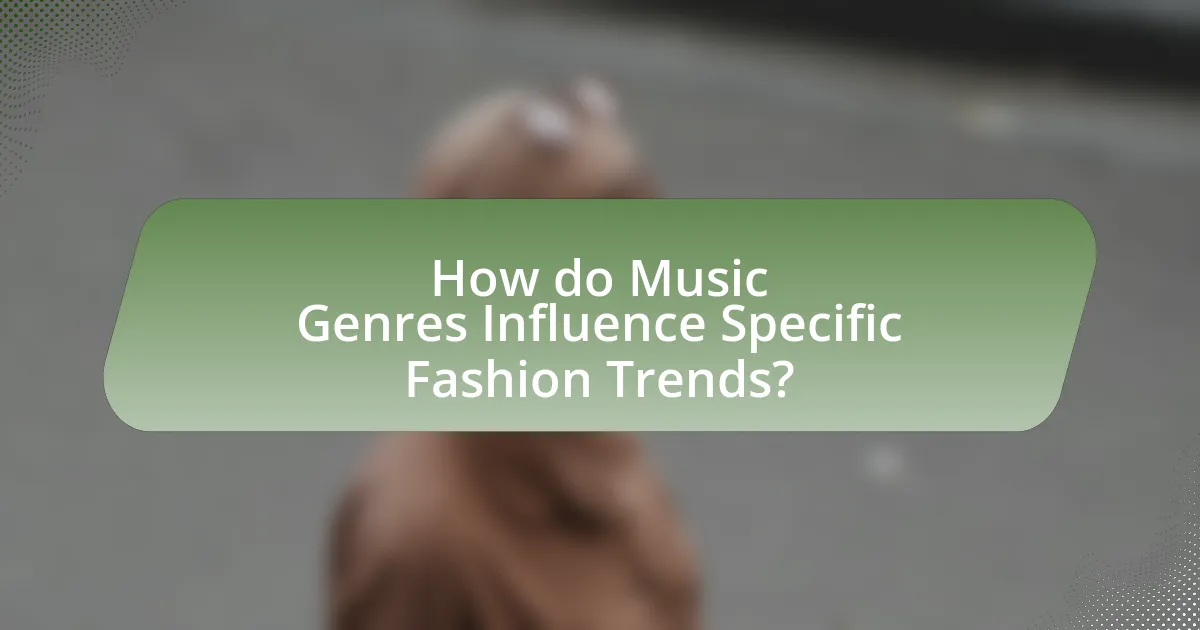
How do Music Genres Influence Specific Fashion Trends?
Music genres significantly influence specific fashion trends by shaping cultural identities and aesthetics associated with each genre. For instance, punk music, emerging in the 1970s, introduced a rebellious fashion characterized by leather jackets, ripped jeans, and distinctive hairstyles, reflecting the genre’s anti-establishment ethos. Similarly, hip-hop culture has popularized streetwear, including oversized clothing, sneakers, and baseball caps, which became mainstream fashion staples in the 1990s and continue to influence contemporary styles. The connection between music and fashion is evident in events like music festivals, where attendees often emulate the styles of their favorite artists, further solidifying the relationship. This interplay demonstrates how music genres not only dictate sound but also serve as a catalyst for evolving fashion trends.
What are the fashion trends associated with rock music?
Fashion trends associated with rock music include leather jackets, band t-shirts, ripped jeans, and combat boots. These elements reflect the rebellious and edgy nature of rock culture, which emerged prominently in the 1950s and 1960s. For instance, the leather jacket became iconic through artists like Elvis Presley and later, punk rock bands in the 1970s, symbolizing defiance and individuality. Band t-shirts serve as a means of expressing allegiance to specific artists or genres, while ripped jeans signify a casual, anti-establishment attitude. Combat boots, popularized by bands like The Ramones, further emphasize the rugged, non-conformist aesthetic inherent in rock music.
How do leather jackets and band tees symbolize rock culture?
Leather jackets and band tees symbolize rock culture by representing rebellion, individuality, and a connection to music. The leather jacket, often associated with iconic rock figures like James Dean and bands such as The Ramones, conveys a sense of toughness and nonconformity. Band tees serve as a medium for fans to express their allegiance to specific artists and genres, showcasing their identity within the rock community. Historically, these garments emerged in the 1950s and 1960s, aligning with the rise of rock ‘n’ roll, and have since become staples in the wardrobes of rock enthusiasts, reinforcing their cultural significance.
What accessories are commonly linked to rock fashion?
Rock fashion is commonly linked to accessories such as leather jackets, studded belts, bandanas, and chunky jewelry. These accessories reflect the rebellious and edgy aesthetic associated with rock music culture. For instance, leather jackets have been a staple since the 1950s, symbolizing defiance and individuality, while studded belts and bracelets often signify a punk influence within rock fashion. Bandanas serve both a practical and stylistic purpose, frequently worn by rock musicians and fans alike. Chunky jewelry, including oversized rings and necklaces, adds to the bold visual statement typical of rock style.
How does pop music influence mainstream fashion trends?
Pop music significantly influences mainstream fashion trends by shaping cultural aesthetics and consumer behavior. Artists like Madonna and Lady Gaga have historically set trends through their distinctive styles, which fans often emulate. For instance, the 1980s saw Madonna popularizing lace gloves and bold accessories, leading to widespread adoption in everyday fashion. Additionally, contemporary pop stars like Billie Eilish have introduced oversized clothing and unique color palettes, impacting retail offerings and consumer preferences. Research indicates that 70% of young consumers are influenced by celebrity styles, demonstrating the direct correlation between pop music and fashion trends.
What role do pop icons play in setting fashion standards?
Pop icons play a significant role in setting fashion standards by influencing public perception and trends through their personal style and public appearances. Their visibility in media, including music videos, concerts, and social media, allows them to showcase unique fashion choices that often become aspirational for fans. For instance, when artists like Madonna in the 1980s or Beyoncé in the 2010s adopted specific styles, those looks quickly gained popularity, leading to widespread emulation. This phenomenon is supported by studies indicating that celebrity endorsements and visibility can increase consumer interest in particular fashion items, demonstrating the direct impact pop icons have on shaping fashion trends.
How do music videos contribute to fashion trends in pop culture?
Music videos significantly contribute to fashion trends in pop culture by showcasing innovative styles and aesthetics that resonate with audiences. Artists often collaborate with fashion designers to create visually striking looks that become iconic, influencing viewers’ clothing choices. For instance, the music video for “Vogue” by Madonna in 1990 popularized high-fashion elements and the concept of modeling poses, leading to a resurgence of interest in vintage couture. Additionally, the rise of platforms like YouTube has allowed music videos to reach global audiences quickly, amplifying their impact on fashion trends. The visibility of these styles in music videos often leads to increased demand for similar clothing in retail markets, demonstrating a direct correlation between music video content and fashion consumer behavior.
What unique fashion elements are found in electronic music scenes?
Unique fashion elements in electronic music scenes include neon colors, oversized silhouettes, and futuristic accessories. These elements reflect the genre’s emphasis on innovation and visual stimulation, often seen in rave culture and festival attire. For instance, the use of LED lights and glow-in-the-dark materials enhances the immersive experience of electronic music events. Additionally, brands like Y-3 and designers such as Rick Owens have incorporated these aesthetics into their collections, further solidifying the connection between electronic music and avant-garde fashion.
How do rave culture and festival fashion intersect?
Rave culture and festival fashion intersect through a shared emphasis on self-expression, vibrant aesthetics, and a sense of community. Rave culture, which emerged in the late 1980s and early 1990s, is characterized by electronic dance music, immersive experiences, and a celebration of individuality, which directly influences the fashion choices seen at festivals. Festival fashion often incorporates bright colors, eclectic patterns, and unique accessories that reflect the energetic and liberating spirit of rave culture.
For instance, the use of neon colors, glitter, and DIY clothing in both rave and festival settings highlights a common desire for visual impact and personal creativity. Additionally, the rise of festival culture in the 2000s has led to a blending of styles, where elements from rave fashion, such as oversized clothing and playful accessories, have become staples at music festivals. This intersection is further supported by the popularity of social media platforms, where festival-goers showcase their outfits, reinforcing the connection between music genres and fashion trends.
What materials and styles are prevalent in electronic music fashion?
Electronic music fashion predominantly features materials such as synthetic fabrics, vinyl, and mesh, alongside styles that include futuristic aesthetics, streetwear, and cyberpunk influences. The use of synthetic materials allows for vibrant colors and unique textures, which are essential in creating the bold visual identity associated with electronic music events. Additionally, the incorporation of streetwear elements reflects the genre’s roots in urban culture, while cyberpunk styles emphasize a blend of technology and rebellion, often seen in the outfits of artists and fans alike. This trend is supported by the rise of festivals and raves, where attendees often showcase these materials and styles, reinforcing their prevalence in the electronic music scene.
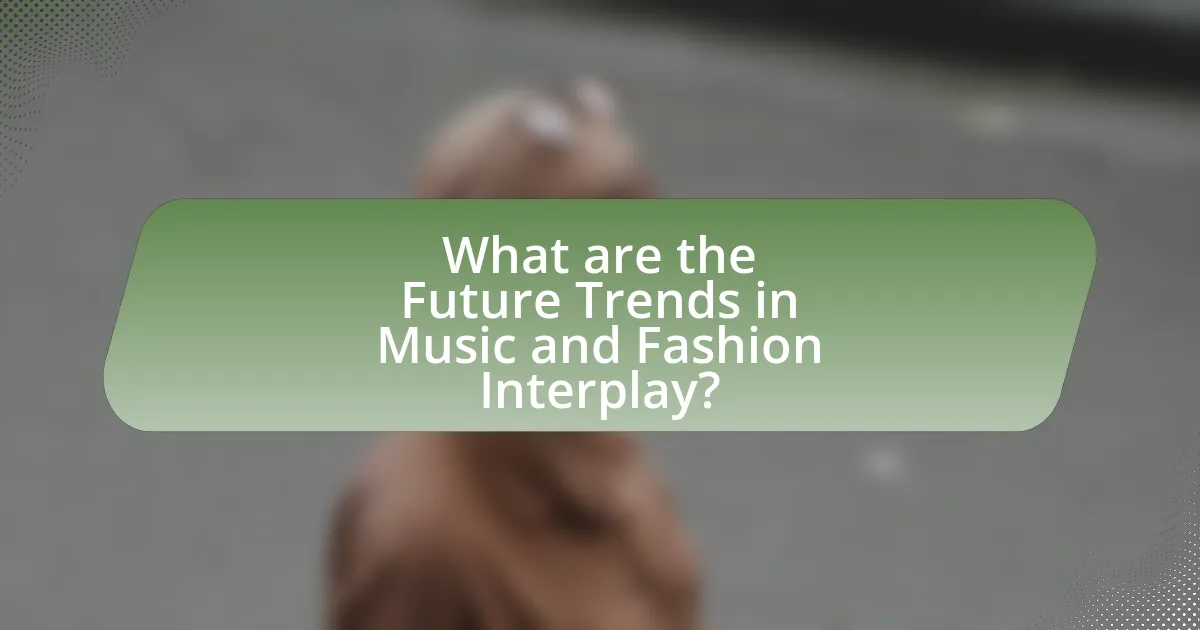
What are the Future Trends in Music and Fashion Interplay?
Future trends in the interplay between music and fashion will increasingly emphasize sustainability and digital integration. As consumers become more environmentally conscious, artists and fashion designers are likely to collaborate on eco-friendly collections that reflect their shared values. Additionally, the rise of virtual concerts and digital fashion shows will blur the lines between physical and digital realms, allowing for innovative expressions of style influenced by music genres. For instance, the popularity of genres like hip-hop and electronic music is expected to drive streetwear trends, while artists will leverage social media platforms to showcase their fashion choices, further influencing consumer behavior.
How is technology changing the relationship between music and fashion?
Technology is transforming the relationship between music and fashion by enabling real-time collaboration and influencing trends through digital platforms. Social media platforms like Instagram and TikTok allow musicians to showcase their fashion choices instantly, leading to rapid trend adoption among fans. For instance, artists such as Billie Eilish and Lil Nas X utilize these platforms to set fashion trends that resonate with their audiences, resulting in a direct correlation between their musical releases and fashion statements. Additionally, advancements in augmented reality (AR) and virtual reality (VR) are creating immersive experiences where fans can engage with both music and fashion, further blurring the lines between the two industries. This interconnectedness is evidenced by the rise of virtual fashion shows and digital clothing, which are often promoted through music videos, illustrating how technology is reshaping the dynamics of music and fashion.
What role do social media platforms play in promoting fashion trends from music genres?
Social media platforms play a crucial role in promoting fashion trends from music genres by providing a space for artists and influencers to showcase their styles, which can quickly gain traction among followers. For instance, platforms like Instagram and TikTok allow musicians to share their fashion choices directly with millions of fans, creating a visual culture that influences consumer behavior. According to a study by the Pew Research Center, 72% of teens use Instagram, making it a powerful tool for trend dissemination. Additionally, viral challenges and hashtags related to music genres often feature specific fashion items, further amplifying their visibility and desirability. This dynamic interaction between music and fashion on social media not only shapes individual style choices but also drives broader fashion trends in the industry.
How are virtual concerts influencing fashion choices among fans?
Virtual concerts are significantly influencing fashion choices among fans by promoting specific styles associated with artists and genres. Fans often emulate the looks of their favorite performers, leading to increased visibility of certain fashion trends. For instance, during the pandemic, artists like Travis Scott and Billie Eilish showcased unique styles in their virtual performances, which resulted in a surge of interest in streetwear and oversized clothing among their fanbases. This phenomenon is supported by data indicating that social media platforms saw a rise in fashion-related posts and searches linked to these artists, demonstrating a direct correlation between virtual concert aesthetics and fan fashion choices.
What emerging music genres are likely to impact future fashion trends?
Emerging music genres such as hyperpop, lo-fi, and trap are likely to significantly impact future fashion trends. Hyperpop, characterized by its eclectic sound and vibrant aesthetics, has already influenced streetwear brands to adopt bold colors and experimental designs. Lo-fi music, often associated with a relaxed, nostalgic vibe, promotes a casual, vintage-inspired fashion that emphasizes comfort and simplicity. Trap music, with its roots in hip-hop culture, continues to shape urban fashion through the popularity of oversized silhouettes, luxury streetwear, and accessories that reflect a blend of high and low culture. These genres not only dictate musical tastes but also inspire visual styles, creating a dynamic interplay between music and fashion.
How do indie and alternative music scenes influence niche fashion markets?
Indie and alternative music scenes significantly influence niche fashion markets by promoting unique styles that reflect their cultural values and aesthetics. These music genres often emphasize individuality and self-expression, leading to the emergence of fashion trends characterized by vintage clothing, DIY elements, and eclectic accessories. For instance, the rise of the indie music scene in the 2000s popularized thrift store shopping and handmade garments, which became staples in niche fashion markets. This influence is evident in brands like Urban Outfitters and Free People, which cater to the aesthetic preferences of indie music fans. Additionally, music festivals such as Coachella have further solidified this connection by showcasing fashion that aligns with the indie and alternative ethos, driving demand for specific styles within niche markets.
What trends are being observed in the fusion of genres and fashion styles?
Current trends in the fusion of genres and fashion styles include the blending of streetwear with high fashion, as seen in collaborations between luxury brands and urban designers. This trend reflects a growing acceptance of casual aesthetics in formal settings, driven by cultural shifts and the influence of music genres like hip-hop and punk. For example, brands such as Off-White and Balenciaga have successfully integrated elements of street culture into their collections, showcasing graphic tees, oversized silhouettes, and bold accessories. Additionally, the rise of gender-fluid fashion is evident, with artists like Harry Styles and Billie Eilish challenging traditional gender norms through their eclectic style choices, further influencing mainstream fashion.
What practical tips can fans use to incorporate music-inspired fashion into their wardrobe?
Fans can incorporate music-inspired fashion into their wardrobe by selecting key pieces that reflect their favorite genres. For example, rock fans can opt for leather jackets, band tees, and distressed jeans, while hip-hop enthusiasts might choose oversized hoodies, snapback caps, and sneakers. Additionally, fans can accessorize with items like statement jewelry or hats that are emblematic of their preferred music style. This approach not only personalizes their look but also aligns with the historical influence of music on fashion, as seen in the 1970s punk movement, which popularized specific styles that are still relevant today.
